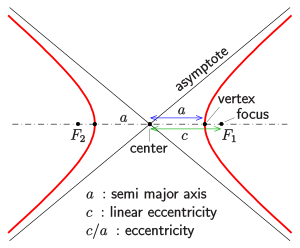Cycling Dynamical Equations of Motion
The process of solving the cycling force equation can be done, but it requires a degree of mathematical skills. It provides what are formaly referred to as the Equations of Motions, but here they ae called simply the motion equations.
What it does provide are actual formulas for v(t) and x(t) which if you understanding the functions tells you intuitively the shapes of these Motion Equations.
Direct Solving of the Force Equation
The following are the motion equations when starting from rest at some point denoted as 0. The mathematical details are involved and we only present the results. What is immediately striking is the presence of these strange functions called Hyperbolic, which are a consequence of the nature of aerodynamic drag.
 What are Hyperbolic Functions?
What are Hyperbolic Functions?
The appearance of tanh() and ln cosh() might appear intimidating. Hyperbolic Functions get their name because the

ir shape is based on hyperbolas. When they show up in formulas, they are telling you what they are modeling have a hyperbolic shape. For example, when you look at the cables on a suspension bridge, you are seeing a practical example of a hyperbola.

What is the Connection between Cycling and Hyperbolic Functions?
The effect of Aerodynamic Dragon CyclistCycle is small at low speeds and limiting at high speeds. When plotted, the Motion Equations show an initial constant rate that flattens out to a limiting terminal velocity. It turns out, that like a suspension bridge cable, its shape is mathematically related to parabolas.
Next Topic: Incremental Numerical Solutions
